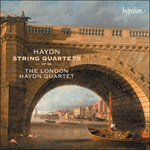
Welcome to Hyperion Records, a British classical label devoted to presenting high-quality recordings of music of all styles and from all periods from the twelfth century to the twenty-first.
Hyperion offers both CDs, and downloads in a number of formats. The site is also available in several languages.
Please use the dropdown buttons to set your preferred options, or use the checkbox to accept the defaults.

| The London Haydn Quartet» More |
The four movements of Op 64 No 2 chart the gradual triumph of B major over B minor. After the close of the first movement, where even the buffo tune acquires an acerbic edge, the B major adagio ma non troppo brings a magical contrast of mood, texture and colour. This is music of seraphic calm, with a minimum of harmonic tension. Formally the movement unfolds as a series of gently ornamental variations on a sustained theme that initially suggests an ancient cantus firmus. But with no clear-cut divisions between the variations (the two halves of the theme are later compressed into one), the impression is of an unbroken meditation.
Worrying obsessively at a nagging repeated figure, the irregularly phrased B minor minuet encloses a major-keyed ländler trio of Schubertian sweetness and grace that turns out to be a free variation of the minuet itself. The gypsy-flavoured finale, growing entirely from its opening theme, makes unsettling play with phrase structure and—in the capricious central development—silence. Then, midway through the recapitulation, Haydn brings back the theme in an emphatic celebration of B major before the music evaporates into the ether.
from notes by Richard Wigmore © 2018
Les quatre mouvements de l’op.64 nº 2 planifient le triomphe progressif de si majeur sur si mineur. Après la conclusion du premier mouvement, où même l’air buffo prend un côté caustique, l’adagio ma non troppo en si majeur apporte un contraste magique d’atmosphère, de texture et de couleur. C’est une musique d’un calme séraphique, avec un minimum de tension harmonique. Sur le plan formel, ce mouvement se déroule comme une série de variations agréablement ornementales sur un thème soutenu qui fait penser d’abord à un cantus firmus ancien. Mais sans aucune division précise entre les variations (les deux moitiés du thème sont ensuite réduite à une), on a une impression de méditation ininterrompue.
Le menuet en si mineur retourne dans tous les sens et de façon obsessionnelle une figure répétée tenace. Il est phrasé irrégulièrement et comporte un trio-ländler en majeur d’une douceur et d’une grâce schubertiennes qui s’avère être une variation libre du menuet lui-même. Le finale à la saveur tzigane, entièrement issu de son thème initial, joue de manière troublante avec la structure de la phrase et—dans le développement central fantasque—le silence. Ensuite, à la moitié de la réexposition, Haydn fait revenir le thème dans une célébration emphatique de si majeur avant de laisser s’envoler la musique dans les espaces célestes.
extrait des notes rédigées par Richard Wigmore © 2018
Français: Marie-Stella Pâris
Über die vier Sätze des op. 64 Nr. 2 hinweg wird der allmähliche Sieg von H-Dur über h-Moll geschildert. Nach dem Schluss des ersten Satzes, in dem selbst die buffo-Melodie aggressive Schärfe annahm, wirkt das Adagio ma non troppo in H-Dur als zauberischer Gegensatz in Stimmung, Satzart und Klangfarbe—eine Musik von seraphischer Ruhe und minimaler harmonischer Spannung. Der Satz entfaltet sich als Reihe sanft ausschmückender Variationen über ein getragenes Thema, das zunächst einen uralten Cantus firmus anzudeuten scheint. Doch weil die Variationen nicht klar voneinander getrennt sind (die zwei Abschnitte des Themas werden später zu einem einzigen komprimiert), entsteht der Eindruck einer einzigen, ungebrochenen Meditation.
Das aus irregulären Phrasen zusammengesetzte h-Moll-Menuett hält sich an einer nervös wiederholten Figur auf und umschließt ein Trio von Schubert’scher Süße und Grazie, das sich als freie Variation des Menuetts erweist. Das Finale lebt ganz von seinem Anfangsthema, in dem alla zingarese mehr als nur anklingt. Es spielt auf beunruhigende Weise mit dem Phrasenaufbau und—in der launischen zentralen Durchführung—mit der Pause. Dann, mitten in der Reprise, überführt Haydn das Thema in ein emphatisches H-Dur, bevor die Musik himmelwärts verhuscht.
aus dem Begleittext von Richard Wigmore © 2018
Deutsch: Friedrich Sprondel
 Haydn: String Quartets Op 64 Haydn: String Quartets Op 64The London Haydn Quartet’s recordings of their namesake continue to win universal plaudits. Those already familiar with some of the most stylish Haydn on record will need little prompting to acquire this highly desirable 2-for-1 album of the Op 64 ...» More |

